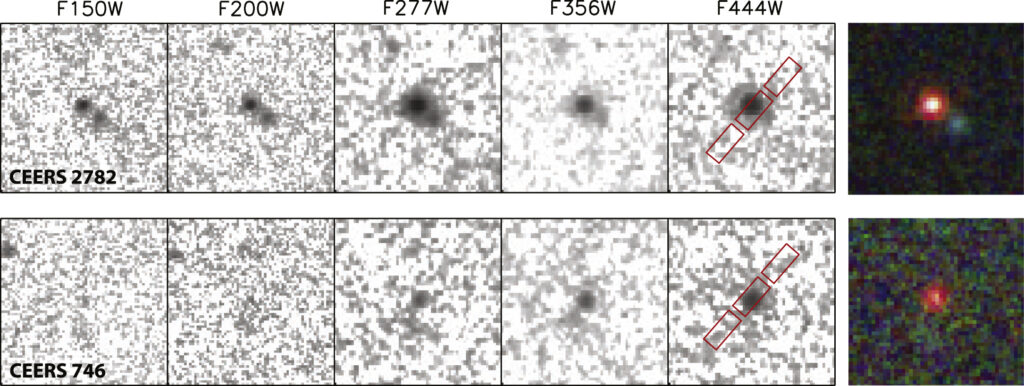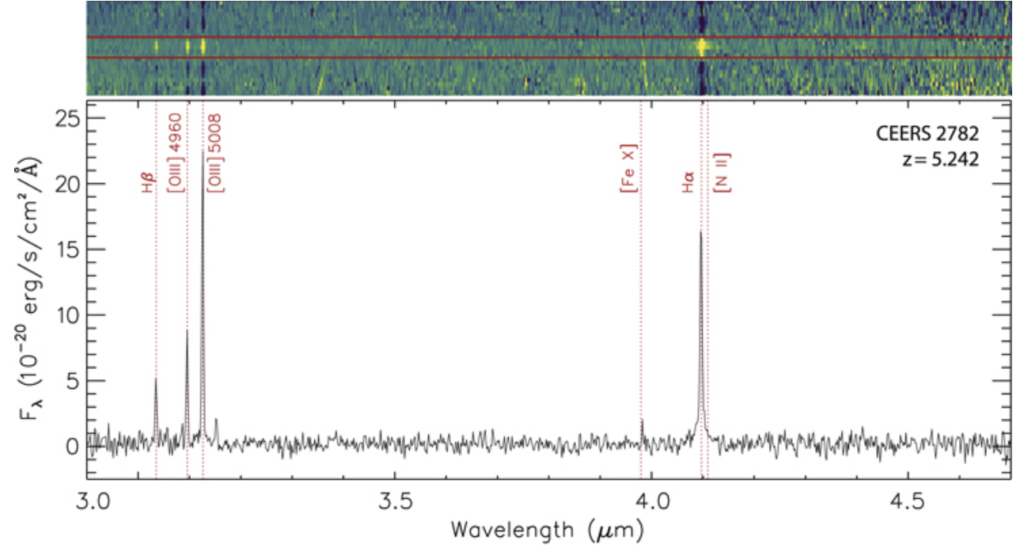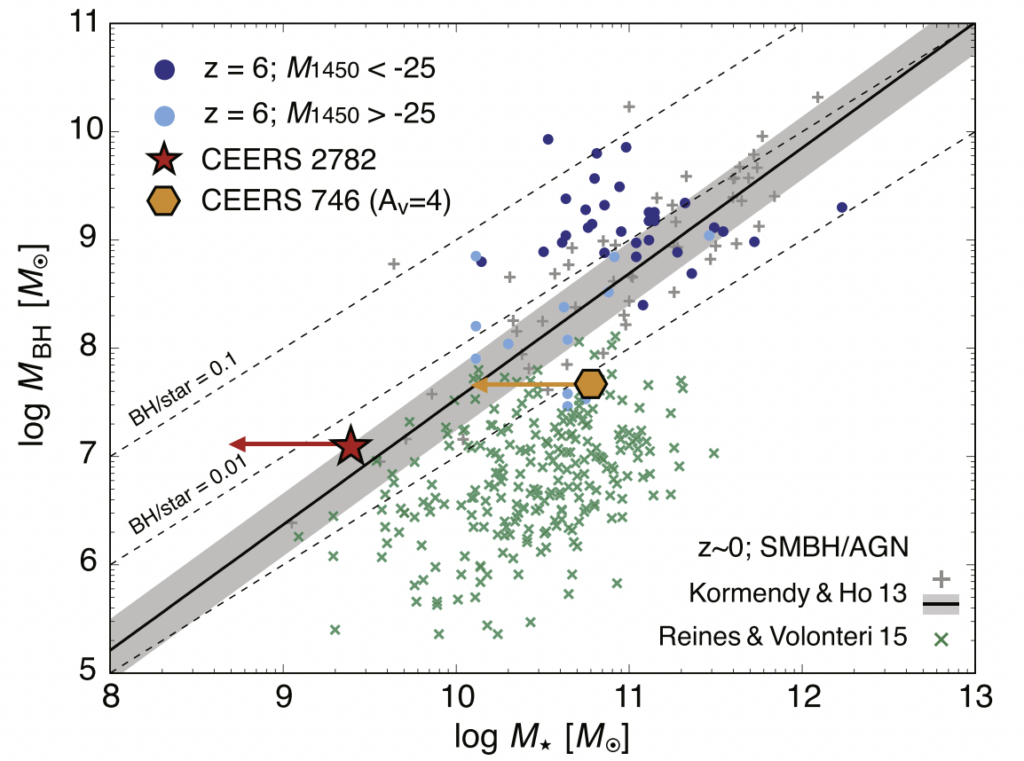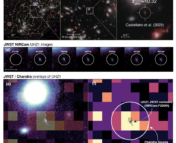Title: Hidden Little Monsters: Spectroscopic Identification of Low-Mass, Broad-Line AGN at z > 5 with CEERS
Authors: Dale D. Kocevski, Masafusa Onoue, Kohei Inayoshi, et al.
First Author’s institution: Department of Physics and Astronomy, Colby College, Waterville, ME 04901, USA
Status: Published in ApJ Letters [open access]
Where are all the lower mass (but supermassive) black holes?
Supermassive black holes (SMBHs) are everywhere! (Or at least, in the center of nearly every massive galaxy). But despite their ubiquity in galaxy centers, we don’t know how they got there in the first place. It’s a chicken or the egg problem: did the galaxy come first, or the supermassive black hole? And how did so much mass build up in the early universe?
One idea is that the SMBH giants grew from smaller progenitors by accumulating mass through their accretion disks. These supermassive black hole “seeds” are thought to have masses of anywhere from 100 to over 100,000 times the mass of the Sun. Although this may sound pretty massive, when we take a look at some of the earliest SMBHs that we’ve been able to observe, we find masses of about a billion times the Sun. We get these masses from quasar surveys – quasars are a very bright form of SMBHs that are actively accreting matter and produce a lot of energy as a result of this accretion (more generally these objects are known as active galaxy nuclei, or AGN for short). These surveys are biased, as they only pick up the most luminous quasars. While deeper surveys, in which photons are collected over a long period of time, do find less extreme quasars in the first billion or so years of the Universe’s history, they’re still much brighter than what we see nearby. How would we find these fainter quasars (and lower mass black holes) then?
Enter (drumroll)… the James Webb Space Telescope (JWST)! Making use of JWST’s impressive sensitivity at near-infrared wavelengths, today’s authors take a look at the spectra of two AGN which push the boundaries of our observations of SMBHs at redshift z>5 (about a billion years after the Big Bang).
The power of emission lines
The authors identify the two AGN (called CEERS 2782 and CEERS 746) using NIRSpec spectroscopy from the Cosmic Evolution Early Release Science (CEERS) program. CEERS 2782 was identified by following up on NIRCam observations that indicated it could be a faint AGN at z~5, while CEERS 746 was discovered in a search of galaxy spectra with photometric redshifts > 8. These two objects are seen in NIRCam photometry in Figure 1. NIRCam photometry is used to fit the spectral energy distributions (SEDs) of CEERS 2782 and CEERS 746. An SED tells us how energy emitted by source is distributed at different wavelengths, and the SED of CEERS 746 drops sharply in ultraviolet wavelengths, implying that the AGN is heavily obscured.

While NIRSpec on JWST observes in near-infrared wavelengths, the redshift associated with the great distance of our sources has us measure what was emitted as the optical part of the spectrum. Looking at the spectrum of CEERS 2782 in Figure 2, we can see several important emission lines. In particular, the broad Hα lines, which are emitted by hydrogen gas in the accretion disk and broadened by orbital motions within the disk, indicates that this object (as well as CEERS 746, which has similarly broad Hα) is a broad-line AGN.
After fitting the spectral lines, the authors take a look at the line ratios of CEERS 2782 and CEERS 746 on BPT diagram and OHNO diagrams. These diagrams compare the strength of lines that are often prominent in AGN ([NII], [O III], and [Ne III]) with lines that are strong in star-forming galaxies (Hα and Hβ), and can differentiate star-forming galaxies from AGN. Although CEERS 2782 and CEERS 746 are both confirmed to be AGN based on the broadness of Hα, the authors find that both line ratio diagrams can’t distinguish whether they are star-forming galaxies at z~5, or AGN with low metallicity. Since the BPT and OHNO diagrams fail to identify CEERS 2782 and CEERS 746 as AGN (and since they both lack x-ray detections), the authors note that these faint, high redshift AGN might only be possible to find by observing broad-emission lines.

To measure the mass of the SMBHs at the centers of CEERS 2782 and CEERS 746, the authors turn to Hα. They find a virial mass, which depends on both the motions and radius of the accretion disk surrounding a SMBH. With an empirical formula that relates the virial mass with two properties of Hα, its brightness (which is related to the radius, since it depends on how much gas is the accretion disk) and its width (which depends on the motions of the gas), the authors calculate the SMBH virial masses. Obscuration will affect this method, because it will lower the brightness of Hα. This means that the black hole mass of CEERS 746, which is likely obscured, may be a lower limit.
Bridging the gap between the nearby and distant Universe

Figure 3 demonstrates how CEERS 2782 helps to bridge the gap between observations of local AGN and high redshift quasars. CEERS 2782 is 1000 times fainter than many of the existing luminosity measurements for quasars at z>5, and its black hole mass is closer to that of nearby AGN. The picture is more complicated for CEERS 746, which if it is heavily obscured by dust (as indicated by its SED), is quite bright. In fact, if the extinction found from SED fitting is correct, CEERS 746 could be accreting matter above the Eddington limit – it would be so bright that its emitted radiation overcomes the gravitational force that holds together the accretion disk, in the process ejecting the matter that obscures the AGN. This implies that CEERS 746 will transition into an unobscured quasar as matter that surrounds it is expelled.
Galaxies and their supermassive black holes seem to grow together. To understand how this relationship came to be in the early universe, we need observations of SMBHs at higher redshifts. In Figure 4, the authors add CEERS 2782 and CEERS 746 to the galaxy stellar mass vs SMBH mass plot. As the stellar masses for CEERS 2782 and CEERS 746 are obtained by SED fitting and the AGN dominates emission, these stellar masses are upper limits, which is indicated by the arrows in Figure 4. While CEERS 2782 falls to the left of the local quasars (its SMBH is more massive relative to its stellar mass), CEERS 746 seems to be more in line with these populations.

CEERS 2782 and CEERS 746 illustrate how JWST allows us to discover low-luminosity AGN at high redshifts. These objects are thought to be more common than the brighter AGN previously discovered at these redshifts, but were inaccessible before JWST. By studying these SMBH in the early universe, we may be able to learn how black hole seeds blossom into SMBHs!
Edited by Konstantin Gerbig
Featured image credit: Adapted from today’s paper




